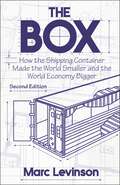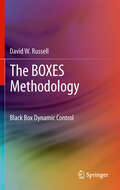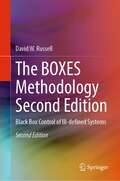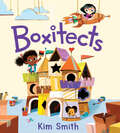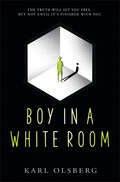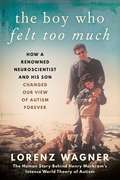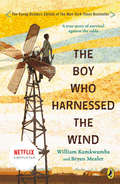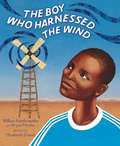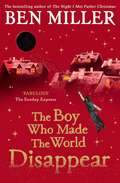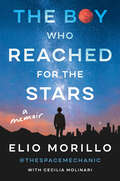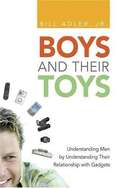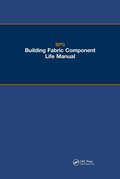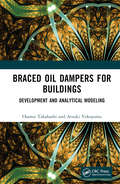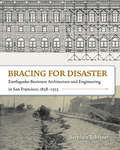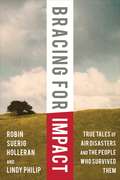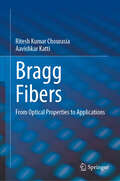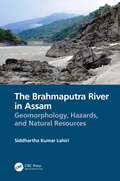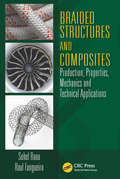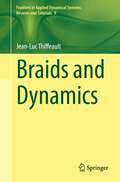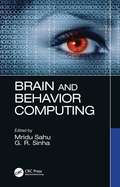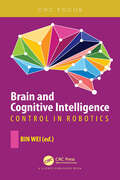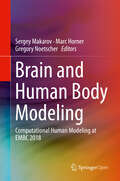- Table View
- List View
The Box: How the Shipping Container Made the World Smaller and the World Economy Bigger - Second Edition with a new chapter by the author
by Marc LevinsonIn April 1956, a refitted oil tanker carried fifty-eight shipping containers from Newark to Houston. From that modest beginning, container shipping developed into a huge industry that made the boom in global trade possible. The Box tells the dramatic story of the container's creation, the decade of struggle before it was widely adopted, and the sweeping economic consequences of the sharp fall in transportation costs that containerization brought about. But the container didn't just happen. Its adoption required huge sums of money, both from private investors and from ports that aspired to be on the leading edge of a new technology. It required years of high-stakes bargaining with two of the titans of organized labor, Harry Bridges and Teddy Gleason, as well as delicate negotiations on standards that made it possible for almost any container to travel on any truck or train or ship. Ultimately, it took McLean's success in supplying U.S. forces in Vietnam to persuade the world of the container's potential. Drawing on previously neglected sources, economist Marc Levinson shows how the container transformed economic geography, devastating traditional ports such as New York and London and fueling the growth of previously obscure ones, such as Oakland. By making shipping so cheap that industry could locate factories far from its customers, the container paved the way for Asia to become the world's workshop and brought consumers a previously unimaginable variety of low-cost products from around the globe. Published in hardcover on the fiftieth anniversary of the first container voyage, this is the first comprehensive history of the shipping container. Now with a new chapter, The Box tells the dramatic story of how the drive and imagination of an iconoclastic entrepreneur turned containerization from an impractical idea into a phenomenon that transformed economic geography, slashed transportation costs, and made the boom in global trade possible.
The BOXES Methodology
by David W. RussellRobust control mechanisms customarily require knowledge of the system's describing equations which may be of the high order differential type. In order to produce these equations, mathematical models can often be derived and correlated with measured dynamic behavior. There are two flaws in this approach one is the level of inexactness introduced by linearizations and the other when no model is apparent. Several years ago a new genre of control systems came to light that are much less dependent on differential models such as fuzzy logic and genetic algorithms. Both of these soft computing solutions require quite considerable a priori system knowledge to create a control scheme and sometimes complicated training program before they can be implemented in a real world dynamic system. Michie and Chambers' BOXES methodology created a black box system that was designed to control a mechanically unstable system with very little a priori system knowledge, linearization or approximation. All the method needed was some notion of maximum and minimum values for the state variables and a set of boundaries that divided each variable into an integer state number. The BOXES Methodology applies the method to a variety of systems including continuous and chaotic dynamic systems, and discusses how it may be possible to create a generic control method that is self organizing and adaptive that learns with the assistance of near neighbouring states. The BOXES Methodology introduces students at the undergraduate and master's level to black box dynamic system control , and gives lecturers access to background materials that can be used in their courses in support of student research and classroom presentations in novel control systems and real-time applications of artificial intelligence. Designers are provided with a novel method of optimization and controller design when the equations of a system are difficult or unknown. Researchers interested in artificial intelligence (AI) research and models of the brain and practitioners from other areas of biology and technology are given an insight into how AI software can be written and adapted to operate in real-time.
The BOXES Methodology Second Edition: Black Box Control of Ill-defined Systems
by David W. RussellThis book focuses on how the BOXES Methodology, which is based on the work of Donald Michie, is applied to ill-defined real-time control systems with minimal a priori knowledge of the system. The method is applied to a variety of systems including the familiar pole and cart. This second edition includes a new section that covers some further observations and thoughts, problems, and evolutionary extensions that the reader will find useful in their own implementation of the method. This second edition includes a new section on how to handle jittering about a system boundary which in turn causes replicated run times to become part of the learning mechanism. It also addresses the aging of data values using a forgetfulness factor that causes wrong values of merit to be calculated. Another question that is addressed is “Should a BOXES cell ever be considered fully trained and, if so, excluded from further dynamic updates”. Finally, it expands on how system boundaries may be shifted using data from many runs using an evolutionary paradigm.
Boxitects
by Kim SmithA STEAM-centered, adorably illustrated picture book about Meg, a brilliant and creative boxitect who creates extraordinary things out of ordinary cardboard boxes.Meg is a brilliant and creative boxitect. She loves impressing her teacher and classmates with what she makes out of boxes.But there’s a new kid at Maker School: Simone. Simone is good at everything, and worst of all, she’s a boxitect too.When the annual Maker Match is held, Meg and Simone are paired as a team but can’t seem to stop arguing. When their extraordinary project turns into a huge disaster, they must find a way to join creative forces, lift each other up, and work together.
Boy in a White Room
by Karl OlsbergA gripping YA sci-fi thriller by German and Spiegel-bestselling author, Karl Olsberg. The Boy in a White Room was nominated for Deutscher Jugendliteraturpreis 2018, Germany’s most prestigious youth fiction award.A fifteen-year-old boy wakes to find himself locked in a white, cube-shaped room. No windows. No doors. Total silence. He has no memories. No clue how he got there. No idea who he is.A computer-generated voice named Alice responds to his questions. Through her, he is able to access the internet. As the boy uncovers snippets of his story -- an attempted abduction, a critial injury, a murder -- it becomes clearer. But when some of the pieces don't fit, how can he tell what's real and what's not? Who can he trust? And who is he really?
The Boy Who Felt Too Much: How a Renowned Neuroscientist and His Son Changed Our View of Autism Forever
by Lorenz WagnerAn International Bestseller, the Story behind Henry Markram&’s Breakthrough Theory about Autism, and How a Family&’s Unconditional Love Led to a Scientific Paradigm Shift Henry Markram is the Elon Musk of neuroscience, the man behind the billion-dollar Blue Brain Project to build a supercomputer model of the brain. He has set the goal of decoding all disturbances of the mind within a generation. This quest is personal for him. The driving force behind his grand ambition has been his son Kai, who has autism. Raising Kai made Henry Markram question all that he thought he knew about neuroscience, and then inspired his groundbreaking research that would upend the conventional wisdom about autism, expressed in his now-famous theory of Intense World Syndrome. When Kai was first diagnosed, his father consulted studies and experts. He knew as much about the human brain as almost anyone but still felt as helpless as any parent confronted with this condition in his child. What&’s more, the scientific consensus that autism was a deficit of empathy didn&’t mesh with Markram&’s experience of his son. He became convinced that the disorder, which has seen a 657 percent increase in diagnoses over the past decade, was fundamentally misunderstood. Bringing his world-class research to bear on the problem, he devised a radical new theory of the disorder: People like Kai don&’t feel too little; they feel too much. Their senses are too delicate for this world.
The Boy Who Harnessed the Wind: Young Readers Edition (P. S. Series)
by Anna Hymas Bryan Mealer William KamkwambaWhen a terrible drought struck William Kamkwamba's tiny village in Malawi, his family lost all of the season's crops, leaving them with nothing to eat and nothing to sell. William began to explore science books in his village library, looking for a solution. There, he came up with the idea that would change his family's life forever: he could build a windmill. Made out of scrap metal and old bicycle parts, William's windmill brought electricity to his home and helped his family pump the water they needed to farm the land.Retold for a younger audience, this exciting memoir shows how, even in a desperate situation, one boy's brilliant idea can light up the world. Complete with photographs, illustrations, and an epilogue that will bring readers up to date on William's story, this is the perfect edition to read and share with the whole family.
The Boy Who Harnessed the Wind: Young Readers Edition
by William Kamkwamba Bryan Mealer Anna HymasNIMAC-sourced textbook
The Boy Who Harnessed The Wind
by William Kamkwamba Bryan Mealer Elizabeth ZunonWhen fourteen-year-old William Kamkwamba's Malawi village was hit by a drought, everyone's crops began to fail. Without enough money for food, let alone school, William spent his days in the library... <P> and figured out how to bring electricity to his village. Persevering against the odds, William built a functioning windmill out of junkyard scraps, and thus became the local hero who harnessed the wind. Lyrically told and gloriously illustrated, this story will inspire many as it shows how - even in the worst of times - a great idea and a lot of hard work can still rock the world.
The Boy Who Made the World Disappear
by Ben Miller&‘A sheer delight for all kids both big AND small&’ Ruth Jones on The Night I Met Father Christmas 'Bubbles with warmth and mischievous humour . . . irresistible' Alexander Armstrong on The Night I Met Father Christmas'Wonderful, funny, magical' Chris Evans on How I Became a Dog Called MidnightEnter a world of wonder with an instant classic from comedian, actor and bestselling children's author, Ben Miller! Harrison tries his best to be good. He doesn&’t steal, he always shares with his sister and he never cheats at board games, but Harrison also has a BIG flaw . . . He can't control his temper!So when he&’s given a black hole instead of a balloon at a party, Harrison jumps at the chance to get rid of everything that makes him cross. But when it&’s not just things he hates that are disappearing into the black hole but things he loves, too, Harrison starts to realize that sometimes you should be careful what you wish for...An out-of-this-world adventure about twists of fate, time travel and troublesome black holes, Ben Miller's stunning storytelling is brought to life with beautiful illustrations from Daniela Jaglenka Terrazzini. Praise for Ben Miller:'A magical adventure' Sunday Express on The Day I Fell Into a Fairytale'Great for reading aloud' The Week Junior on The Day I Fell Into a Fairytale'A fire-side gem of a story' Abi Elphinstone on The Night I Met Father Christmas'Fabulous' Sunday Express on The Boy Who Made the World Disappear'Enchanting, funny and intriguing in equal measure' Philip Ardagh on The Night I Met Father Christmas'Each of [Ben&’s] five books is joyous and thoughtful' Red Magazine
The Boy Who Reached for the Stars: A Memoir
by Elio Morillo"Heartwarming... infectious ... [Morillo's The Boy Who Reached for the Stars] is every bit the inspiration he means it to be." –Kirkus ReviewsThe engineer known as the “space mechanic” speaks to both our future and past in this breathless memoir of his journey from Ecuador to NASA and beyond.Elio Morillo’s life is abruptly spun out of orbit when economic collapse and personal circumstances compel his mother to flee Ecuador for the United States in search of a better future for her son. His itinerant childhood sets into motion a migration that will ultimately carry Elio to the farthest expanse of human endeavor: space.Overcoming a history of systemic adversity and inequality in public education, Elio forged ahead on a journey as indebted to his galactic dreams as to a loving mother whose sacrifices safeguarded the ground beneath his feet. Today, Elio is helping drive human expansion into the solar system and promote the future of human innovation—from AI and robotics to space infrastructure and equitable access.The Boy Who Reached the Stars is both a cosmic and intimate memoir spun from a constellation of memories, reflections, and intrepid curiosity, as thoroughly luminous as the stars above.
Boys and Their Toys: Understanding Men by Understanding Their Relationship with Gadgets
by Bill Adler"The key to understanding men is in understanding how they relate to their gadgets. Just because they may seem to show more interest in their computers. . . or their remote controls... or their fancy watches or their power mowers or their stereos... doesn't mean that their toys are really the most important things in their life. In Boys and Their Toys, bestselling author Bill Adler, Jr. explains how men use toys to assert their independence and freedom, relieve stress, connect to their lost childhood, and even express their nurturing side (without having to admit it). Written in Adler's fun, humorous style, the book reveals how women can: * learn how a man's interest in particular ""toys"" can be used to predict his behavior * know when a guy's passion for gadgets crosses the line into obsession and what to do about it * take advantage of the human-gadget relationship to improve the human-human relationship Smart and funny, Boys and Their Toys helps readers understand what makes their men tick. . . and grow closer with them in the process. "
The BPG Building Fabric Component Life Manual
by Building Performance Group Ltd,This manual provides a comprehensive source of building component life-span and maintenance data for commercial and industrial building components, following the same format as the ground-breaking HAPM Component Life Manual for domestic buildings. Each building component is allocated its own data sheet on which a number of generic descriptions are provided together with assessed life-spans and maintenance requirements. References to the relevant standards and codes of practice are also included.
Braced Oil Dampers for Buildings: Development and Analytical Modeling
by Osamu Takahashi Atsuki YokoyamaThe high damping force of oil damper vibration control systems in buildingsoffers relative safety during earthquakes and at a low environmentalcost. The oil damper is connected using braces in series and is installed withpins to the building structure, which minimizes the impact on the buildingstructure and allows installation and removal with ease.This is the first book detailing experimental work and cases of the use ofoil dampers in buildings. It shows their effectiveness by detailing the testingand analysis of buildings with them placed at braced positions, exposed tosmall amplitude vibration, and without them.• The only comprehensive presentation of oil damper vibration control• Covers analysis and design, with case studies and details of testingand experimental resultsThe book is organized systematically to suit students and junior professionalsin structural design as well as more specialist engineers. An additionalPython code sample is available online for learning the behaviors of oildampers (Jupyter Notebook environment required).Osamu Takahashi is a professor at Tokyo University of Science, founderof Science Kozo Inc., and an advisor to the New International StructuralDesign & Engineering Challenge Association, in Japan.Atsuki Yokoyama works in the Research and Development Departmentof Sanwa Tekki Corporation and has a PhD in Engineering from TokyoUniversity of Science.
Bracing for Disaster: Earthquake-resistant Architecture and Engineering in San Francisco, 1838-1933
by Stephen TobrinerFor the past one hundred and fifty years, architects and engineers have quietly been learning from each quake and designing newer earthquake-resistant building techniques and applying them in an ongoing effort to save San Francisco. Bracing for Disaster is the first history of seismic engineering in San Francisco. In the language of a skilled teacher, Tobriner examines what really happened in the city's earthquakes—which buildings were damaged, which survived, and who were the unsung heroes—in a fresh appraisal of a city responding to repeated devastation. Filled with more than two hundred photographs, diagrams, and illustrations, this is a revealing look at the history of buildings by a true expert, and it offers lessons not just for San Francisco but for any city beset by natural disasters.
Bracing for Disaster: Earthquake-Resistant Architecture and Engineering in San Francisco, 1838–1933
by Stephen Tobriner&“The first history of seismic engineering in San Francisco . . . spiced with survivor and eyewitness accounts. &”—Midwest Book Review For the past one hundred and fifty years, architects and engineers have quietly been learning from each quake and designing newer earthquake-resistant building techniques and applying them in an ongoing effort to save San Francisco. Bracing for Disaster is a fresh appraisal of a city responding to repeated devastation. In the language of a skilled teacher, Tobriner examines what really happened during the city&’s earthquakes—which buildings were damaged, which survived, and who were the unsung heroes. Filled with more than two hundred photographs, diagrams, and illustrations, this is a revealing look at the history of buildings by a true expert, and it offers lessons not just for San Francisco but for any city beset by natural disasters. &“The real saga is how a fast-growing city grapples with the reality that it has more to worry about than fires and fog. The core of the story is fairly technical, rooted in the crude intuitive ways in which builders reacted to a seismic threat they could neither measure nor define. But Tobriner crafts the story well.&”—SFGate
Bracing for Impact: True Tales of Air Disasters and the People Who Survived Them
by Robin Suerig Holleran Lindy Philip"Surviving is a true blessing that few get to experience. ” Being strapped in the seat of a plane as it plunges into a nosedive midair is everyone’s worst nightmare. Bracing for Impact’s compilers and contributors know. They have both lived out that fear and survived, albeit badly hurt, in their own plane crashes. In this collection of true-life survivor tales, people from all walks of life--a freelance writer, a crew member of the Lynyrd Skynyrd band, a naval flight surgeon, a teenager, and a newlywed on her honeymoon, among others--recount their traumatic narrow escapes as engines stalled, fuel ran out, hazardous weather conditions descended, and landings did not go according to plan. In the face of death, as life flashed before their eyes--or not, as some wryly note--these survivors encountered the terrific split of before and after the crash. Their lives, though preserved, would change forever. Perhaps more significant than the crash itself is how each story plays out in the aftermath of the ordeal. In heart-wrenching, unrelenting honesty, these stories explore the wide spectrum of impacts on survivors--ranging from debilitating fear, post-traumatic stress disorder, and substance abuse, to a renewed sense of urgency, where survivors swear to live each day to the fullest and rededicate their lives to helping others. Including the 1977 story of the Lynyrd Skynyrd plane crash that killed lead singer Ronnie Van Zant, guitarist Steve Gaines, and vocalist Cassie Gaines, Bracing for Impact is as much a horrific account of air disasters as it is a celebration and recognition of the people who survived them.
Bragg Fibers: From Optical Properties to Applications
by Ritesh Kumar Chourasia Aavishkar KattiThis book highlights the guiding mechanisms as well as the most current and important results in the field of innovative, bio-inspired Bragg fibers. While conventional optical fibers (COF) have several advantages over traditional waveguides, they also suffer from a number of disadvantages which are not present in Bragg fibers due to their minimal nonlinearities, lack of polarization or birefringence effect, lack of Fresnel reflections at the open fiber end, and absence of material or cladding losses. A natural platform for biological and chemical sensing, and with potential to boost communication systems' speed and bandwidth, the primary goal of this book is to apprise readers in academia and industry of properties of EM wave propagation in Bragg fibers with a defect layer. Their major applications in bio/chemical sensing, fuel adulteration sensing, high-temperature sensing, optical dual-channel inline filtering, optical de-multiplexers, optical couplers, and nonlinear soliton generation are presented in detail, along with comparisons of Bragg fibers with alternative structures and their relative pros and cons.
The Brahmaputra River in Assam: Geomorphology, Hazards, and Natural Resources
by Siddhartha Kumar LahiriThis holistic book covers the richest area in North East India in terms of both explored and foreseen reserves of fossil fuels and other natural resources. Using a multidisciplinary approach, GIS, and geospatial data gathered from different case studies included, this book helps readers develop a thorough understanding of a highly dynamic big river, the Brahmaputra, and use it as a comprehensive resource for further understanding the science of rivers. It discusses the causal factors of decadal-scale fluvial dynamics, the nature of fluvial dynamics, lateral variability of the older flood plains and neotectonics in the shallow subsurface, and the overall trend of basin evolution at different depths.
Braided Structures and Composites: Production, Properties, Mechanics, and Technical Applications (Composite Materials)
by Sohel Rana Raul FangueiroBraiding is a very old textile manufacturing technology that traditionally has been used to produce items like ropes, shoe laces, and cables. Recently, braiding has gained attention in the medical, aerospace, transportation, and civil engineering communities, among others, due to its ability to produce structures that can fulfill the explicit deman
Braids and Dynamics (Frontiers in Applied Dynamical Systems: Reviews and Tutorials #9)
by Jean-Luc ThiffeaultThis monograph uses braids to explore dynamics on surfaces, with an eye towards applications to mixing in fluids. The text uses the particular example of taffy pulling devices to represent pseudo-Anosov maps in practice. In addition, its final chapters also briefly discuss current applications in the emerging field of analyzing braids created from trajectory data. While written with beginning graduate students, advanced undergraduates, or practicing applied mathematicians in mind, the book is also suitable for pure mathematicians seeking real-world examples. Readers can benefit from some knowledge of homotopy and homology groups, but these concepts are briefly reviewed. Some familiarity with Matlab is also helpful for the computational examples.
Brain and Behavior Computing
by Mridu SahuBrain and Behavior Computing offers insights into the functions of the human brain. This book provides an emphasis on brain and behavior computing with different modalities available such as signal processing, image processing, data sciences, statistics further it includes fundamental, mathematical model, algorithms, case studies, and future research scopes. It further illustrates brain signal sources and how the brain signal can process, manipulate, and transform in different domains allowing researchers and professionals to extract information about the physiological condition of the brain. Emphasizes real challenges in brain signal processing for a variety of applications for analysis, classification, and clustering. Discusses data sciences and its applications in brain computing visualization. Covers all the most recent tools for analysing the brain and it’s working. Describes brain modeling and all possible machine learning methods and their uses. Augments the use of data mining and machine learning to brain computer interface (BCI) devices. Includes case studies and actual simulation examples. This book is aimed at researchers, professionals, and graduate students in image processing and computer vision, biomedical engineering, signal processing, and brain and behavior computing.
Brain and Cognitive Intelligence: Control in Robotics
by Bin WeiThe aim of the book is to introduce the state-of-the-art technologies in the field of brain and cognitive intelligence used in robotics control, particularly on studying how the brain learns and controls complex motor skills and how to replicate these in robots. This will be the first book that systematically and thoroughly deals with the above topics. Advances made in the past decades are described. Interesting topics such as human-robot interactions, neurorobotics, biomechanics in robotic control, robot vision, force control, and control and coordination of humanoid robots are covered.
Brain and Human Body Modeling: Computational Human Modeling at EMBC 2018
by Sergey Makarov Marc Horner Gregory NoetscherThis open access book describes modern applications of computational human modeling with specific emphasis in the areas of neurology and neuroelectromagnetics, depression and cancer treatments, radio-frequency studies and wireless communications. Special consideration is also given to the use of human modeling to the computational assessment of relevant regulatory and safety requirements. Readers working on applications that may expose human subjects to electromagnetic radiation will benefit from this book’s coverage of the latest developments in computational modelling and human phantom development to assess a given technology’s safety and efficacy in a timely manner.Describes construction and application of computational human models including anatomically detailed and subject specific models;Explains new practices in computational human modeling for neuroelectromagnetics, electromagnetic safety, and exposure evaluations;Includes a survey of modern applications for which computational human models are critical;Describes cellular-level interactions between the human body and electromagnetic fields.
